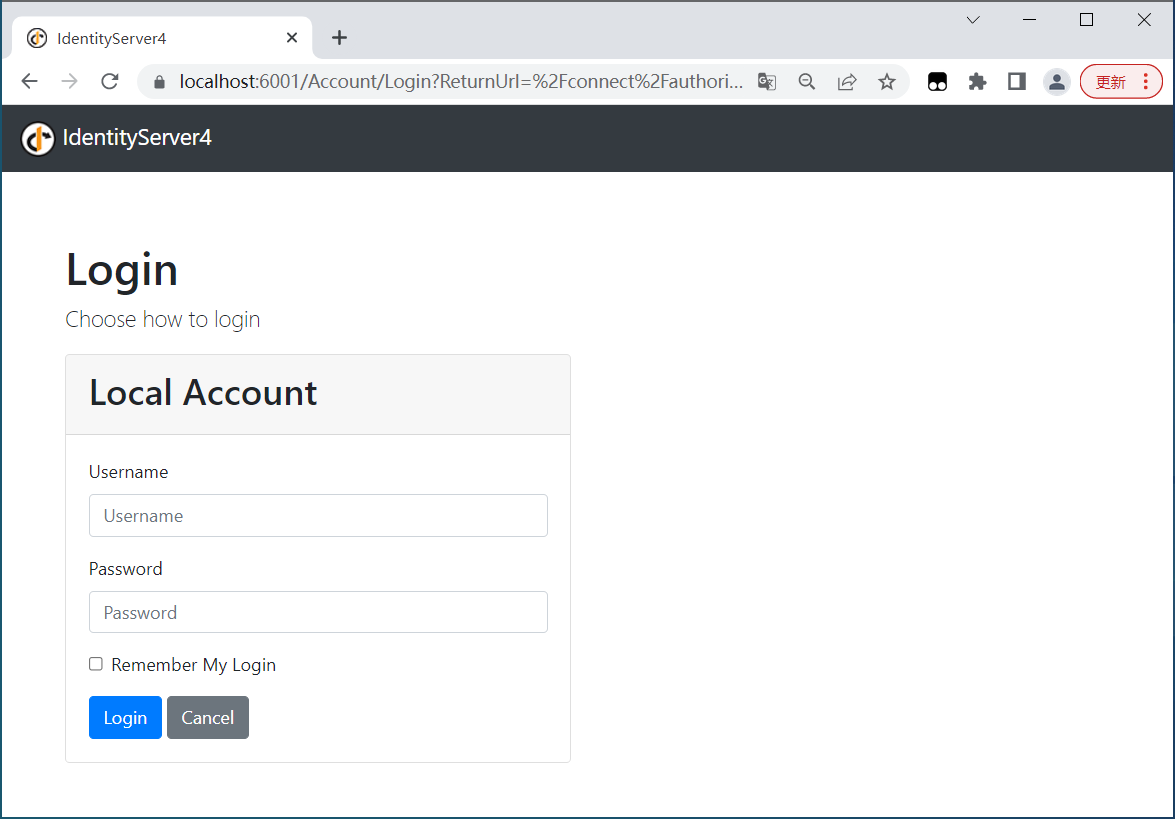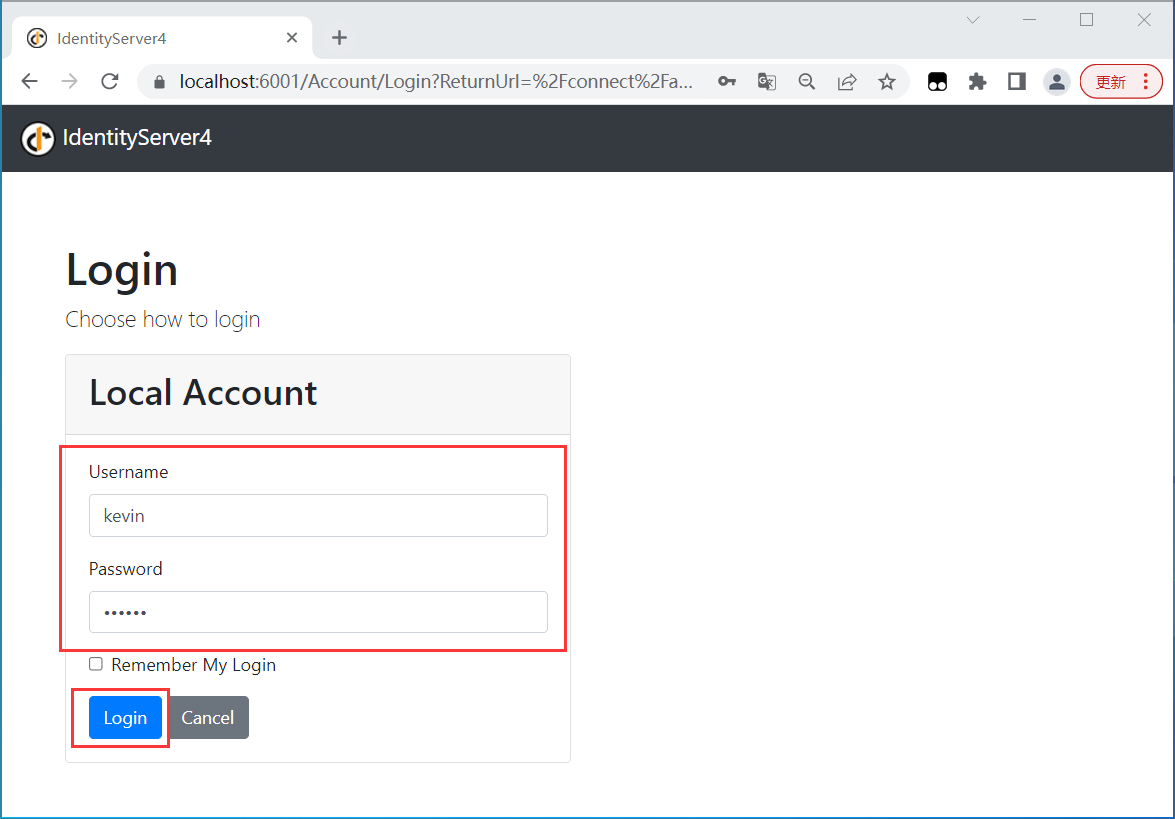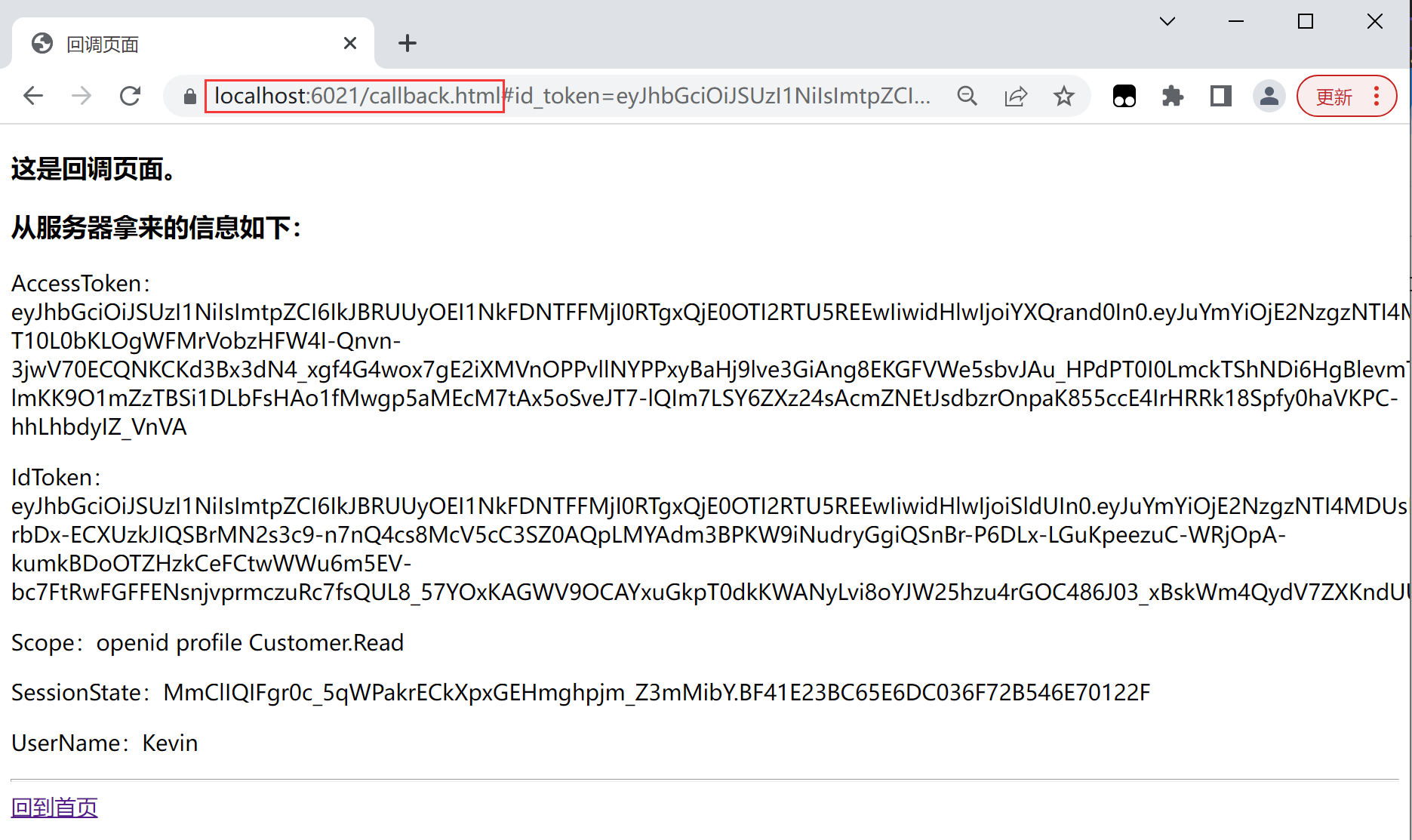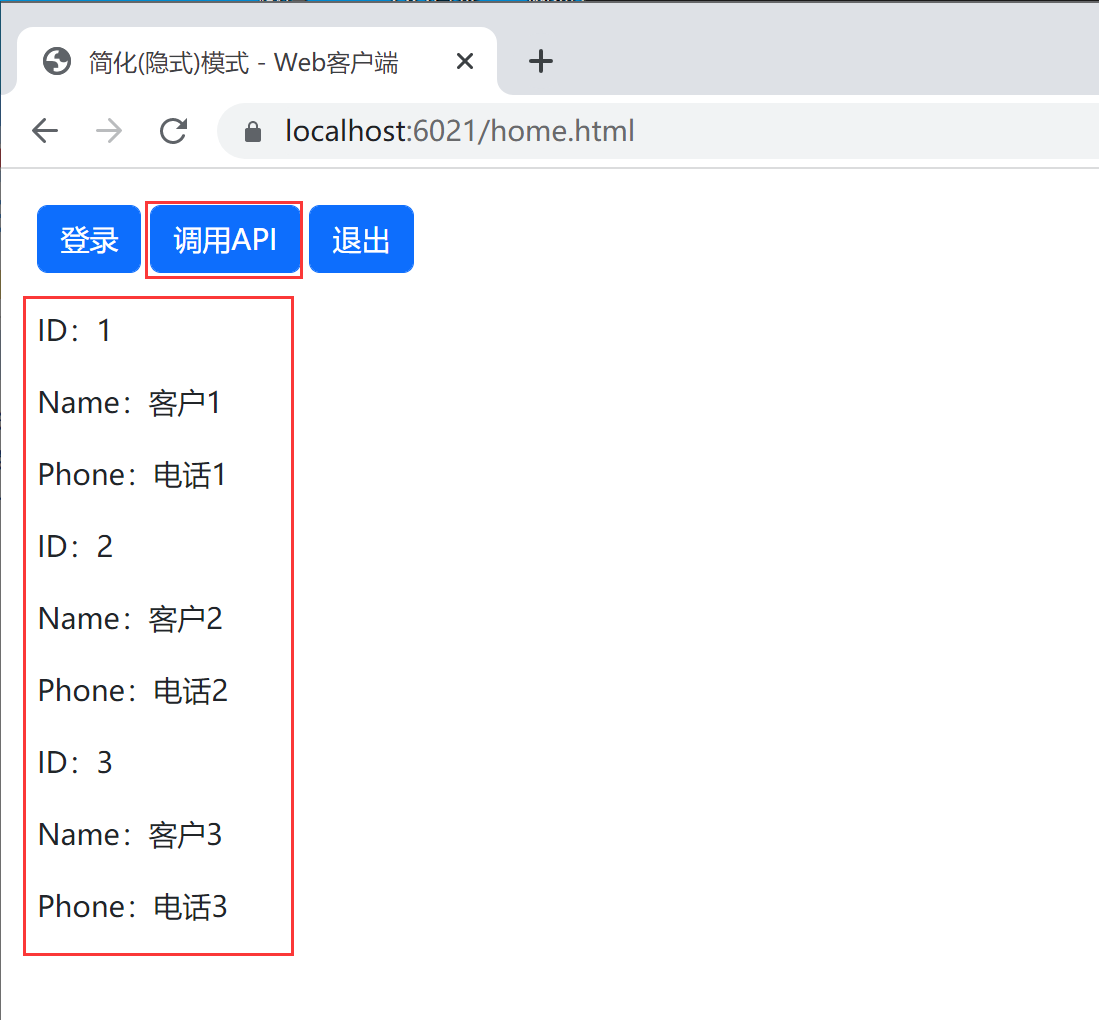IdentityServer4:简化(隐式)模式
IdentityServer4:简化(隐式)模式
简化(隐式)模式流程是:
用户从客户端跳转到认证服务器,然后输入用户名和密码, 密码验证通过后,进入授权界面,选择授权范围,最后同意后才跳转回客户端页面。而在返回的跳转Url链接中包含了:id_token 和 access_token, 客户端就是从这个返回的Url中提取到 access_token。
故:简化(隐式)模式模式比较适用于纯前端项目、微信开发等,比如前后端分离的项目中的 Vue、Angual、Rect 纯前端项目。
Api 资源项目
创建项目
打开 VS,创建一个“AspNet Core WebApi” 项目, 名为:Dotnet.WebApi.Ids4.CustomerApi
依赖包
添加依赖包
<PackageReference Include="Microsoft.AspNetCore.Authentication.JwtBearer" Version="7.0.3" />
添加认证方案
修改 Program.cs 为如下代码:
using Microsoft.AspNetCore.Authentication.JwtBearer;
namespace Dotnet.WebApi.Ids4.CustomerApi
{
public class Program
{
public static void Main(string[] args)
{
Console.Title = "CustomerAPI服务器";
var builder = WebApplication.CreateBuilder(args);
builder.Services.AddControllers();
builder.Services.AddAuthentication(JwtBearerDefaults.AuthenticationScheme)
.AddJwtBearer(options =>
{
//IdentityServer4地址
options.Authority = "https://localhost:6001";
//认证的ApiResource名称
options.Audience = "CustomerAPIResource";
//使用JWT认证类型
options.TokenValidationParameters.ValidTypes = new[] { "at+jwt" };
});
//配置跨域。
builder.Services.AddCors(options =>
{
options.AddPolicy("AppCors", policy => policy.WithOrigins("https://localhost:6021")
.AllowAnyHeader()
.AllowAnyMethod()
.AllowCredentials()
);
});
builder.Services.AddEndpointsApiExplorer();
builder.Services.AddSwaggerGen();
var app = builder.Build();
// Configure the HTTP request pipeline.
if (app.Environment.IsDevelopment())
{
app.UseSwagger();
app.UseSwaggerUI();
}
app.Urls.Add("https://*:6011");
app.UseHttpsRedirection();
//启用跨域中间件
app.UseCors("AppCors");
//身份验证
app.UseAuthentication();
//授权
app.UseAuthorization();
app.MapControllers();
app.Run();
}
}
}
其中,
(1)添加 JWT 认证:
builder.Services.AddAuthentication(JwtBearerDefaults.AuthenticationScheme)
.AddJwtBearer(options =>
{
//IdentityServer4地址
options.Authority = "https://localhost:6001";
//认证的ApiResource名称
options.Audience = "CustomerAPIResource";
//使用JWT认证类型
options.TokenValidationParameters.ValidTypes = new[] { "at+jwt" };
});
https://localhost:6001 是认证服务器地址。
(2) 纯前端项目存在跨域问题,故这里资源服务器为纯前端项目提供跨域支持。
//配置跨域。
builder.Services.AddCors(options =>
{
options.AddPolicy("AppCors", policy => policy.WithOrigins("https://localhost:6021")
.AllowAnyHeader()
.AllowAnyMethod()
.AllowCredentials()
);
});
app.UseCors("AppCors");
这里,我们先假设纯前端项目的地址为:https://localhost:6021
添加 Api
新增文件:Controllers/CustomerController.cs
using Microsoft.AspNetCore.Authorization;
using Microsoft.AspNetCore.Http;
using Microsoft.AspNetCore.Mvc;
namespace Dotnet.WebApi.Ids4.CustomerApi.Controllers
{
[Authorize]
[Route("api/[controller]")]
[ApiController]
public class CustomerController : ControllerBase
{
/// <summary>
/// 获取客户信息列表。
/// </summary>
/// <returns></returns>
[HttpGet("GetList")]
public IEnumerable<Customer> GetList()
{
return new List<Customer>
{
new Customer{ Id=1, Name="客户1", Phone="电话1"},
new Customer{ Id=2, Name="客户2", Phone="电话2"},
new Customer{ Id=3, Name="客户3", Phone="电话3"},
};
}
}
}
其中:
(1)在控制器上添加特性:[Authorize],这样只有登录用户才能访问,这样就起到保护了Api资源的目的。
Customer.cs
namespace Dotnet.WebApi.Ids4.CustomerApi
{
/// <summary>
/// 客户实体模型
/// </summary>
public class Customer
{
public int Id { get; set; }
public string? Name { get; set; }
public string? Phone { get; set; }
}
}
认证服务器
创建项目
打开 VS,创建一个“AspNet Core 空” 项目,名为:Dotnet.WebApi.Ids4.AuthService
依赖包
添加依赖包
<PackageReference Include="IdentityServer4" Version="4.1.2" />
配置 IdentityServer4
创建文件:IdentityConfig.cs,添加如下代码:
using IdentityModel;
using IdentityServer4;
using IdentityServer4.Models;
using IdentityServer4.Test;
using System.Security.Claims;
namespace Dotnet.WebApi.Ids4.AuthService
{
public static class IdentityConfig
{
/// <summary>
/// 配置IdentityResource。
/// </summary>
/// <returns></returns>
public static IEnumerable<IdentityResource> GetIdentityResources()
{
return new List<IdentityResource> {
new IdentityResources.OpenId(),
new IdentityResources.Profile()
};
}
/// <summary>
/// 配置API作用域。
/// </summary>
/// <returns></returns>
public static IEnumerable<ApiScope> GetApiScopes()
{
return new List<ApiScope>
{
//客户相关API作用域
new ApiScope("Customer.Read","读取客户信息。"),
new ApiScope("Customer.Add","添加客户信息。"),
//共享API作用域
new ApiScope("News","新闻信息。")
};
}
/// <summary>
/// 配置ApiResource。
/// </summary>
/// <returns></returns>
public static IEnumerable<ApiResource> GetApiResources()
{
//将多个具体的APIScope归为一个ApiResource。
return new List<ApiResource>()
{
new ApiResource("CustomerAPIResource", "客户资源")
{
Scopes={ "Customer.Read", "Customer.Add", "News" }
}
};
}
/// <summary>
/// 配置客户端应用。
/// </summary>
/// <returns></returns>
public static IEnumerable<Client> GetClients()
{
#region 简化(隐式)模式
return new List<Client>
{
new Client
{
//客户端ID。
ClientId="WebClient",
//客户端名称。
ClientName="Web客户端",
//授权模式为Implicit,表示简化授权模式。
AllowedGrantTypes=GrantTypes.Implicit,
//授权操作页面支持,为true表示显示授权界面,否则不显示。
RequireConsent=true,
//身份认证成功之后重定向到客户端的回调地址。
RedirectUris={ "https://localhost:6021/callback.html"},
//退出时重定向到客户端的地址。
PostLogoutRedirectUris={"https://localhost:6021/home.html"},
//允许跨域操作,设置允许跨域的客户端地址。
AllowedCorsOrigins={"https://localhost:6021"},
//允许浏览器传递AccessToken。
AllowAccessTokensViaBrowser=true,
//设置AccessToken能访问的作用域。
AllowedScopes={
IdentityServerConstants.StandardScopes.OpenId,
IdentityServerConstants.StandardScopes.Profile,
"Customer.Read" ,//可访问的API。
}
}
};
#endregion
}
/// <summary>
/// 配置用户。
/// </summary>
/// <returns></returns>
public static List<TestUser> GetUsers()
{
#region 简化模式
return new List<TestUser>
{
new TestUser
{
SubjectId="00001",
Username="Kevin",
Password="123456",
//添加声明信息
Claims =
{
new Claim(JwtClaimTypes.Name, "Kevin"),
new Claim(JwtClaimTypes.GivenName, "Mi"),
new Claim(JwtClaimTypes.FamilyName, "Kala"),
new Claim(JwtClaimTypes.Email, "Kevin@donet.com"),
new Claim(JwtClaimTypes.EmailVerified, "true", ClaimValueTypes.Boolean)
}
}
};
#endregion
}
}
}
代码解析:
(1)简化模式通过在客户端和认证服务器往返的URL来传递数据,使用了 Openid Connect 协议,故得在IdentityServer中配置 Openid 信息, 这是简化模式必须得添加的:
/// <summary>
/// 配置IdentityResource。
/// </summary>
/// <returns></returns>
public static IEnumerable<IdentityResource> GetIdentityResources()
{
return new List<IdentityResource> {
new IdentityResources.OpenId(),
};
}
如果需要客户端要求能获取到用户信息,还得添加new IdentityResources.Profile(), 如下所示:
public static IEnumerable<IdentityResource> GetIdentityResources()
{
return new List<IdentityResource> {
new IdentityResources.OpenId(),
+ new IdentityResources.Profile()
};
}
(2)如下代码添加了 Client,并将其授权模式设置为:简化模式, 并设置密码,和 Scope:
new Client
{
//客户端ID。
ClientId="WebClient",
//客户端名称。
ClientName="Web客户端",
//授权模式为Implicit,表示简化授权模式。
AllowedGrantTypes=GrantTypes.Implicit,
//授权操作页面支持,为true表示显示授权界面,否则不显示。
RequireConsent=true,
//身份认证成功之后重定向到客户端的回调地址。
RedirectUris={ "https://localhost:6021/callback.html"},
//退出时重定向到客户端的地址。
PostLogoutRedirectUris={"https://localhost:6021/home.html"},
//允许跨域操作,设置允许跨域的客户端地址。
AllowedCorsOrigins={"https://localhost:6021"},
//允许浏览器传递AccessToken。
AllowAccessTokensViaBrowser=true,
//设置AccessToken能访问的作用域。
AllowedScopes={
IdentityServerConstants.StandardScopes.OpenId,
IdentityServerConstants.StandardScopes.Profile,
"Customer.Read" ,//可访问的API。
}
}
其中:
(1)设置授权模式:AllowedGrantTypes=GrantTypes.Implicit
(2)身份认证成功之后重定向到客户端的回调地址: RedirectUris={ "https://localhost:6021/callback.html"},
(3)退出时重定向到客户端的地址:PostLogoutRedirectUris={"https://localhost:6021/home.html"},
(4)跨域支持: AllowedCorsOrigins={"https://localhost:6021"},
(5)设置Scope:AllowedScopes = { ... }
(3) 添加用户:因为简化模式需要用户参与,故得添加用户;
return new List<TestUser>
{
new TestUser
{
SubjectId="00001",
Username="Kevin",
Password="123456",
//添加声明信息
Claims =
{
new Claim(JwtClaimTypes.Name, "Kevin"),
new Claim(JwtClaimTypes.GivenName, "Mi"),
new Claim(JwtClaimTypes.FamilyName, "Kala"),
new Claim(JwtClaimTypes.Email, "Kevin@donet.com"),
new Claim(JwtClaimTypes.EmailVerified, "true", ClaimValueTypes.Boolean)
}
}
};
集成 IdentityServer4
添加 IdentityServer4的Quickstart UI
因为简化(隐式)模式流程是:
用户从客户端跳转到认证服务器,然后输入用户名和密码, 密码验证通过后,进入授权界面,选择授权范围,最后同意后才跳转回客户端页面。
在返回的跳转链接中包含了:id_token 和 access_token, 客户端就是从这个返回的Url中提取到 access_token。
从以上过程可以看到,IdentityServer4 认证服务器得有一个界面,好在已经一个开源项目:Quickstart UI,可以直接用即可。
下载 Quickstart UI:https://github.com/IdentityServer/IdentityServer4.Quickstart.UI,
然后把 Quickstart、Views、wwwroot 三个文件夹复制到 Dotnet.WebApi.Ids4.AuthService 项目根目录下。
由于 Quickstart UI 使用了 AspNet Core 的 MVC 框架,所以得在 Program.cs 开启 MVC 框架:
//注册MVC服务。
builder.Services.AddControllersWithViews();
......
//终结点
app.MapControllerRoute(
name: "default",
pattern: "{controller=Home}/{action=Index}/{id?}");
Program.cs
修改 Program.cs 为如下代码:
namespace Dotnet.WebApi.Ids4.AuthService
{
public class Program
{
public static void Main(string[] args)
{
Console.Title = "认证和授权服务器";
var builder = WebApplication.CreateBuilder(args);
//注册MVC服务。
builder.Services.AddControllersWithViews();
//注册IdentityServer4组件
builder.Services.AddIdentityServer()
.AddInMemoryIdentityResources(IdentityConfig.GetIdentityResources())
.AddInMemoryApiScopes(IdentityConfig.GetApiScopes())
.AddInMemoryApiResources(IdentityConfig.GetApiResources())
.AddInMemoryClients(IdentityConfig.GetClients())
.AddTestUsers(IdentityConfig.GetUsers())
.AddDeveloperSigningCredential(); // 添加临时内存中的证书
var app = builder.Build();
//修改端口号
app.Urls.Add("https://*:6001");
//启用静态文件
app.UseStaticFiles();
//启用HTTPS转向
app.UseHttpsRedirection();
//启用路由
app.UseRouting();
//添加IDS4中间件。
//在浏览器中输入如下地址访问 IdentityServer4 的发现文档:https://localhost:6001/.well-known/openid-configuration
app.UseIdentityServer();
//授权
app.UseAuthorization();
//终结点
app.MapControllerRoute(
name: "default",
pattern: "{controller=Home}/{action=Index}/{id?}");
app.Run();
}
}
}
其中,app.Urls.Add("https://*:6001"); 设置认证服务器的监听端口为:6001
简化(隐式)模式客户端
创建项目
创建一个 “AspNet Core 空项目”,名为:Dotnet.WebApi.ImplicitClient。这个项目没用到 AspNet Core 的任何功能,仅仅只是作为一个静态文件站点,即:一个纯前端项目。
添加 JS 库
创建"wwwroot"文件夹,然后选择该文件夹,右键【添加/客户端库】,添加bootract.min.css、jquery.min.js、 oidc-client.js文件。
其中:oidc-client.js库用来处理 Openid connect 登录、获取保存AccesssToken、登出等功能。
创建页面:home.html
<!DOCTYPE html>
<html>
<head>
<meta charset="utf-8" />
<title>简化(隐式)模式 - Web客户端</title>
<link href="/bootstrap/css/bootstrap.css" rel="stylesheet" />
<script src="jquery/jquery.js"></script>
<script src="oidc-client/oidc-client.js"></script>
</head>
<body>
<div style="margin:20px;">
<input type="button" class="btn btn-primary" onclick="login()" value="登录" />
<input type="button" class="btn btn-primary" onclick="CallApi()" value="调用API" />
<input type="button" class="btn btn-primary" onclick="Signout()" value="退出" />
</div>
<div id="apiData" style="margin:20px;"></div>
<script>
//客户端配置。
this.config = {
authority: "https://localhost:6001",
client_id: "WebClient",
redirect_uri: "https://localhost:6021/callback.html",
response_type: "id_token token",
scope: "openid profile Customer.Read", //访问权限范围。
post_logout_redirect_uri: "https://localhost:6021/home.html",
};
//根据配置信息创建用户管理对象。
this.userManager = new Oidc.UserManager(this.config);
//登录
function login() {
//跳转到IDS4的登录页面。
this.userManager.signinRedirect();
this.userManager.getUser().then(function (user) {
if (user) { //如果登录,在浏览器控制台输出用户信息。
console.log(user.profile)
} else { //如果未登录,则提示请登录。
console.log("请登录");
}
});
}
//调用API
function CallApi() {
var that = this;
//登录成功之后有了access_token,就可以调用API资源服务器上的API了。
this.userManager.getUser().then(function (user) {
//要调用的API资源URL地址。
var url = 'https://localhost:6011/api/customer/getlist';
var r = '';
$.ajax({
type: 'get',
contentType: 'application/json',
url: url,
beforeSend: function (xhr) {
//获取Token
var accessToken = user.access_token;
//使用Token请求资源
xhr.setRequestHeader('Authorization', 'Bearer ' + accessToken);
},
//获取的数据[{},{},{}]
success: function (data) {
$.each(data, function (n, value) {
r += "<p>ID:" + value.id + "</p>" +
"<p>Name:" + value.name + "</p>" +
"<p>Phone:" + value.phone + "</p>";
$("#apiData").html(r);
});
},
error: function (xhr) {
console.log(xhr.statusCode);
}
})
});
}
//退出
function Signout() {
this.userManager.signoutRedirect();
}</script>
</body>
</html>
创建页面:callback.html
<!DOCTYPE html>
<html>
<head>
<meta charset="utf-8" />
<title>回调页面</title>
<script src="jquery/jquery.js"></script>
<script src="oidc-client/oidc-client.js"></script>
</head>
<body>
<h3>这是回调页面。</h3>
<script>//获取回调后的用户信息。
new Oidc.UserManager().signinRedirectCallback().then(function (user) {
console.log(user);
var u = "<p>AccessToken:" + user.access_token + "</p>" +
"<p>IdToken:" + user.id_token + "</p>" +
"<p>Scope:" + user.scope + "</p>" +
"<p>SessionState:" + user.session_state + "</p>" +
"<p>UserName:" + user.profile.name + "</p>";
$("#userInfo").html(u);
}).catch(function (e) {
console.log(e);
});</script>
<h3>从服务器拿来的信息如下:</h3>
<div id="userInfo"></div>
<hr />
<div>
<a href="home.html">回到首页</a>
</div>
</body>
</html>
Program.cs
将 Program.cs 的代码修改为;
namespace Dotnet.WebApi.ImplicitClient
{
public class Program
{
public static void Main(string[] args)
{
var builder = WebApplication.CreateBuilder(args);
var app = builder.Build();
app.Urls.Add("https://*:6021");
//启用静态文件
app.UseStaticFiles();
app.Run();
}
}
}
只是启用静态文件中间件,作为一个纯前端客户端。
运行结果
访问客户端主页:https://localhost:6021/home.html

点击【登录】按钮,跳转到 IdentityServer4 认证服务器,

此时的 Url 为:
https://localhost:6001/Account/Login?ReturnUrl=/connect/authorize/callback?client_id=WebClient&redirect_uri=https://localhost:6021/callback.html&response_type=id_token token&scope=openid profile Customer.Read&state=0f388a11a35d484382298f04064f6f4c&nonce=cbee67183fb84a2b9546880028f51af8
Url中包含了 OAuth2.0 协议的简化(隐式)模式规定的相关参数,比如:
- ReturnUrl=/connect/authorize/callback
- client_id=WebClient
- redirect_uri=https://localhost:6021/callback.html
- response_type=id_token token
- scope=openid profile Customer.Read
- state=0f388a11a35d484382298f04064f6f4c&nonce=cbee67183fb84a2b9546880028f51af8
输入用户名和密码,点击登录:

然后跳转到授权页面:
https://localhost:6001/consent?returnUrl=/connect/authorize/callback?client_id=WebClient&redirect_uri=https://localhost:6021/callback.html&response_type=id_token token&scope=openid profile Customer.Read&state=0f388a11a35d484382298f04064f6f4c&nonce=cbee67183fb84a2b9546880028f51af8

点击【Yes, Allow】进行授权。
授权成功后,返回客户端页面,返回的Url为:
https://localhost:6021/callback.html#id_token=eyJhbGciOiJSUzI1NiIsImtpZCI6IkJBRUUyOEI1NkFDNTFFMjI0RTgxQjE0OTI2RTU5REEwIiwidHlwIjoiSldUIn0.eyJuYmYiOjE2NzgzNTI4MDUsImV4cCI6MTY3ODM1MzEwNSwiaXNzIjoiaHR0cHM6Ly9sb2NhbGhvc3Q6NjAwMSIsImF1ZCI6IldlYkNsaWVudCIsIm5vbmNlIjoiY2JlZTY3MTgzZmI4NGEyYjk1NDY4ODAwMjhmNTFhZjgiLCJpYXQiOjE2NzgzNTI4MDUsImF0X2hhc2giOiJUbWlOUVBLMDhza0c1TzBlSm1XeTlnIiwic19oYXNoIjoiNS1xT2ZoRkJlSmFYVzVCZFhIV3VfQSIsInNpZCI6IkU0RkIwRjNDNTA2RDNFNTRGRkM2M0EyN0Q1ODE0MDU0Iiwic3ViIjoiMDAwMDEiLCJhdXRoX3RpbWUiOjE2NzgzNTI1NDMsImlkcCI6ImxvY2FsIiwiYW1yIjpbInB3ZCJdfQ.YkOxIOtlkYfjumDIo5ZxrbQaMmESWsi5Fm_VllWIXz6ICKoTAlV5JYG-rbDx-ECXUzkJIQSBrMN2s3c9-n7nQ4cs8McV5cC3SZ0AQpLMYAdm3BPKW9iNudryGgiQSnBr-P6DLx-LGuKpeezuC-WRjOpA-kumkBDoOTZHzkCeFCtwWWu6m5EV-bc7FtRwFGFFENsnjvprmczuRc7fsQUL8_57YOxKAGWV9OCAYxuGkpT0dkKWANyLvi8oYJW25hzu4rGOC486J03_xBskWm4QydV7ZXKndUUz910f1d0nioHisud8Ff1B_hOOqn6vb9NfLy77Vpqqo6AlZ5quzn8P0w&access_token=eyJhbGciOiJSUzI1NiIsImtpZCI6IkJBRUUyOEI1NkFDNTFFMjI0RTgxQjE0OTI2RTU5REEwIiwidHlwIjoiYXQrand0In0.eyJuYmYiOjE2NzgzNTI4MDUsImV4cCI6MTY3ODM1NjQwNSwiaXNzIjoiaHR0cHM6Ly9sb2NhbGhvc3Q6NjAwMSIsImF1ZCI6IkN1c3RvbWVyQVBJUmVzb3VyY2UiLCJjbGllbnRfaWQiOiJXZWJDbGllbnQiLCJzdWIiOiIwMDAwMSIsImF1dGhfdGltZSI6MTY3ODM1MjU0MywiaWRwIjoibG9jYWwiLCJqdGkiOiJCNDVCNzkwRjE2N0EzQzIwRERGQjk0MThEQzRBQUY1MiIsInNpZCI6IkU0RkIwRjNDNTA2RDNFNTRGRkM2M0EyN0Q1ODE0MDU0IiwiaWF0IjoxNjc4MzUyODA1LCJzY29wZSI6WyJvcGVuaWQiLCJwcm9maWxlIiwiQ3VzdG9tZXIuUmVhZCJdLCJhbXIiOlsicHdkIl19.OuOX-T10L0bKLOgWFMrVobzHFW4I-Qnvn-3jwV70ECQNKCKd3Bx3dN4_xgf4G4wox7gE2iXMVnOPPvllNYPPxyBaHj9lve3GiAng8EKGFVWe5sbvJAu_HPdPT0I0LmckTShNDi6HgBlevmTPzROLH_7bGg3jTpwQRBuZhJgaWxE29Fbqw6CynZTI22hsthPK0m66XGSz8o8ilpscFa04e6fxvvl-lmKK9O1mZzTBSi1DLbFsHAo1fMwgp5aMEcM7tAx5oSveJT7-lQIm7LSY6ZXz24sAcmZNEtJsdbzrOnpaK855ccE4IrHRRk18Spfy0haVKPC-hhLhbdyIZ_VnVA&token_type=Bearer&expires_in=3600&scope=openid profile Customer.Read&state=0f388a11a35d484382298f04064f6f4c&session_state=MmClIQIFgr0c_5qWPakrECkXpxGEHmghpjm_Z3mMibY.BF41E23BC65E6DC036F72B546E70122F
我们可以看到:返回的Url中包含了Openid Connect 协议和 OAuth2.0 协议的相关参数,比如:
- id_token=eyJhbGciOiJ...
- access_token=yJhbGciOi...
- token_type=Bearer
- scope=openid profile Customer.Read
- expires_in=3600
- state=0f388a11a35d484382298f04064f6f4c

最后返回到主页,点击【调用API】按钮,我们可以看到通过 AccessToken 访问资源服务受保护的数据:



